Five days in Kyoto, Japan is an ideal amount of time to explore the traditional area of Japan.
Located in the Kansai area of Kyoto Prefecture, Kyoto (京都) is a must-visit destination for any Japan itinerary. It’s easy to get to Kyoto from Tokyo or Osaka via train.
If it’s your first visit to Kyoto, you’ll love seeing top UNESCO World Heritage sites, jaw-dropping landscapes, and many beautiful temples and shrines. It’s an opportunity to see what traditional life was like at Japan’s former capital.
We’ve been to Kyoto two times and love everything that Kyoto has to offer. It’s a relatively large city with over 1.5 million people living there, so there are plenty of things to do in Kyoto to keep you occupied for 5 days.
With the help of our favorite travel bloggers, we’ve put together this incredible 5 days in Kyoto itinerary and narrowed down the best places to visit in Kyoto. This suggested Kyoto itinerary is packed with various sightseeing activities, but don’t feel obligated to see everything.
We recommend that you see at least 2-3 attractions per day and alter the schedule as needed based on your interests. We want you to enjoy your vacation and not feel overwhelmed and burned out.
If you’re on a travel budget, choose a couple of temples and shrines that you’d like to visit. Otherwise, the admission costs can quickly add up.
Continue reading on how to spend 5 days in Kyoto to help with your future Japan travel planning.
Click on the links below to jump to a certain section in this Kyoto 5 day itinerary:
*Disclaimer: Visiting Kyoto? This post contains affiliate links. If you click on them and make a purchase for your Kyoto travels, we receive a small commission. There is no additional cost to you. Appreciate the support.
Map of Where to Go in Kyoto in 5 Days
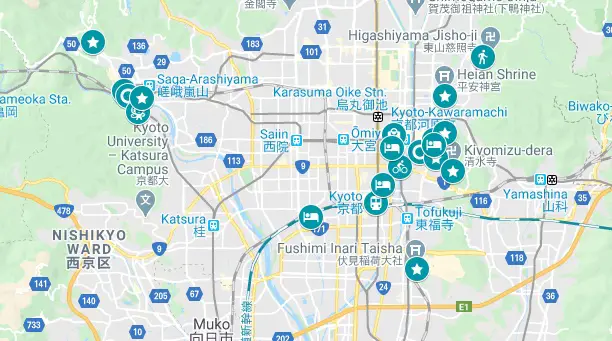
Click on the map to see the locations of where to go on your 5 days in Kyoto. Credit: Map data: Google
How to Get to Kyoto Via Train
Depending on your starting location, visitors tend to visit Kyoto from Tokyo or Osaka. The easiest way to travel between these cities is by taking the shinkansen high-speed train.
We highly recommend that you purchase the wide-area Japan Rail (JR) pass since you can use the pass on local train and bullet trains on Hikari or Sakura trains (excluding Nozomi and Mizuho trains) along the JR lines throughout Japan. If you plan to go to other places beyond Kyoto such as Osaka and further west (ie: Kyushu area), the JR pass will be worth the cost of the pass. There are 7, 14, and 21 day passes available. You’ll need to buy your JR pass before arriving in Japan.
Save money and buy your JR pass for a discount here.
From Tokyo to Kyoto
Take the local train to either Tokyo Station (東京駅) or Shinagawa Station (品川駅). From Tokyo Station to Kyoto Station (京都駅), the direct route will take 2 hours 34 minutes. From Shinagawa Station, it’ll take 2 hours 27 minutes.
From Osaka to Kyoto
If you’re coming from the Osaka International Airport (airport code: KIX), head to the JR shinkansen ticket office to exchange your JR pass voucher for the physical pass. From there, ask the ticket agent to make a reservation for the JR Haruka Limited Express train to go to Kyoto. The Haruka trains are decorated with Hello Kitty decor so it’s very adorable. This is the fastest way to get to Kyoto so allocate around 70 minutes for transportation.
If you don’t have the JR Pass, you can purchase the Haruka Limited Express train tickets here.
If coming from Osaka Station (大阪駅) to Kyoto Station, you can take the special rapid service train via Tokaido-Sanyo line or limited express trains via Thunderbird which will take 30 minutes.
How to Get Around Kyoto
There are many public transportation options in Kyoto to consider traveling to see the major attractions.
1. Walking
We love walking around Kyoto. It’s a large area, so you’ll need to combine your walking with another form of transportation. You’ll hit your daily step goal of 10,000 steps in no time.
2. Trains and Buses
There are several passes to consider if you want to take advantage of the trains and/or buses.
If you’re using the JR line, you can use your JR pass to go on any of the lines. Here is a map of the West JR lines that you can take from Kyoto. There are local lines that you can take such as the Keihan, Hankyu, and others.
Taking the bus is also a convenient way to travel to Kyoto attractions. There is a Kyoto City Bus and a Kyoto Bus. Kyoto City Bus #100, 101, and 102 pass through the major temple areas in the central area. It’s worth it to get the bus pass as not all of the temples are next to a train station.
Since it can get confusing on which trains and buses to take in Kyoto, you may want to consider getting a Kyoto Pass where you can have access to all Kyoto train lines, Kyoto City Bus, and Kyoto bus for a 1 or 2-day pass which can be purchased at Kyoto Station. Bus passes are also available. Check out more information here.
3. Bicycle
Kyoto is a bike-friendly place as you can cycle to many highlights. We’ll share a suggested bike route that you can take on your first day in Kyoto.
4. Tour
While this itinerary is based on a DIY approach, you can take several guided day tours. Here are some walking tour options to consider:
Kyoto Itinerary Day 1: Higashiyama and Gion Districts
On your first day in Kyoto, we’re exploring the central area of Kyoto, including Higashiyama and Gion districts.
Explore Kyoto by bicycle.
By Clemens, Travellers Archive
Kyoto, Japan’s ancient imperial city, is full of temples, parks and shrines. The best way to explore the sights of Kyoto is on a bicycle. It was the right decision that we made. Carefree and with the best weather, navigate through the narrow streets of the historically most important city in Japan and tour the history of the land of the rising sun.
Our path initially led us down to the Kamo River and to the bicycle rental company, Gojo Cycle (京都五条サイクル) where we borrowed two bikes for the whole day. Here is a suggested bike route of what to see in Kyoto:
Start at Kiyomizu-dera Temple (清水寺) which offers a great view over the entire city. Kiyomizu-dera is known for its large wooden terrace which was built in front of the main hall on the mountain slope.
Afterward, head to Maruyama Park (円山公園) which is the oldest park in the city. This park is the best during the cherry blossom season, but even without blooming trees, it’s a great escape.
From there, go straight to the oldest street in town, Ishibei-koji. Unfortunately, it’s not the best street to cycle through. Our advice is to leave your bikes somewhere where you can lock them and enjoy this street by foot.
If you have additional time and energy, you can cycle to the Nanzen-ji Temple (南禅寺) and through the Philosopher’s Path. (More information on these two sites are below.)
Gojo Cycle Address: Japan, 〒600-8029 Kyoto, Shimogyo Ward, 五条東入る北側 西橋詰町795-4 (〒600-8029 京都府京都市下京区 五条東入る北側 西橋詰町795-4)
Rental cost: 800-1,200 yen ($7.50-$11.30) for a full day (9:00am-6:00pm) or 500-800 yen ($4.70-$7.50) for half day rental (1:00pm-6:00pm) depending on bicycle style
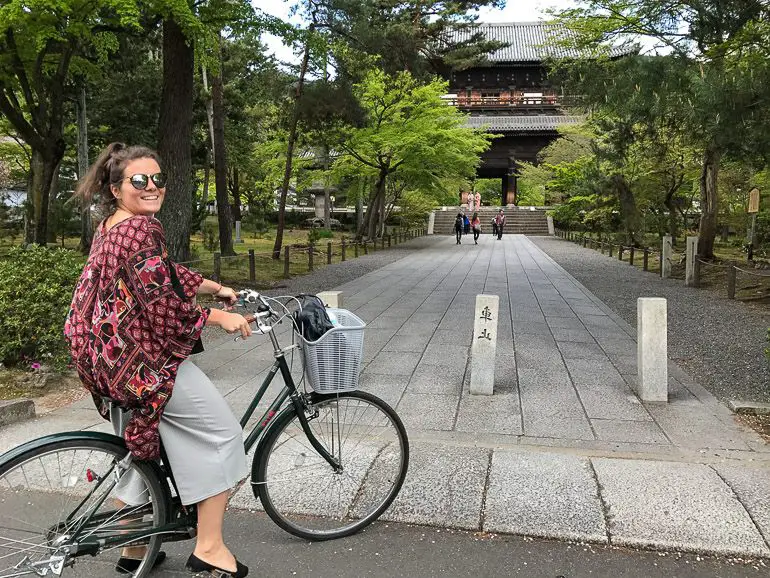
Riding a bicycle is a unique way to explore Kyoto and visit the top sights. Photo credit: Travellers Archive
Not interested in cycling? Walk or take public transportation to the following places below.
1. Spend the day exploring Higashiyama District.
By Amy, Family Globetrotters
The Higashiyama District of Kyoto represents quintessential Japan and not to be missed. It’s a well-preserved historic district with narrow cobblestone streets, traditional merchant shops, and old wooden residences. The most beautiful part of the district is right in between Kiyomizu-dera (清水寺)and Yasaka Shrine but it does also mean it’s the busiest sector of the Higashiyama.
These streets are filled with both pilgrims and tourists which lends itself to excellent retail opportunities. The lanes showcase quaint and gorgeous cafes, restaurants, shops, and traditional pottery workshops. These restaurants and shops open around 10:00am and close around 5:00pm.
Therefore, the best time to visit the streets of Higashiyama is early in the morning when neither the shopkeepers, temple goers, or tourists are even up and about. The famous Ninenzaka steps are stunning at 7:00am as you get to experience it in its full glory. By the time you head out at noon, it’s so busy you won’t even be able to see the steps and you’ll be rubbing shoulders with people for kilometers.
How to Get There: The closest metro station along the Keihan Main Line is Kiyomizu-Gojo Station (清水五条駅) or Gion-Shijo Station (祇園四条駅). From both these stations, it’s another 10-15 minutes walk to the start of the famous part of the district. Alternatively, you can take Kyoto City Bus #86, 100, 106, 110, or 206 in the direction of Kiyomizu-dera from Kyoto Station (京都駅) and it’ll take you closer to the district.
2. Check out Kennin-ji Temple.
By Alyse, The Invisible Tourist
As one of Japan’s ancient capitals, Kyoto has been known to be a very popular tourist destination in recent years. Crowding at major attractions has led some curious travelers to wander off the beaten path in Kyoto. A visit to Kennin-ji (建仁寺) in the Higashiyama area of the city will reward visitors who do just that.
Kennin-ji boasts the title of the oldest Zen temple in Kyoto and is one not to miss for art lovers. Founded by a monk who brought Zen Buddhism to Japan in the 13th century, the temple is of great historical significance and houses precious artworks relating to Zen.
While the temple has a lovely zen rock garden, the star attraction here is undoubtedly within the temple’s main hall. Prepare to gasp at the incredible hand-painted dragons that appear to be dancing on the halls’ ceiling, twisting and baring their teeth. The attention to detail is breathtaking!
Be prepared to take off your shoes to walk within the old temple and wear the supplied slippers to enter the main hall.
Address: 584 Komatsucho, Higashiyama Ward, Kyoto, 605-0811, Japan (〒605-0811 京都府京都市東山区小松町584)
Opening Hours: 10:00am-5:00pm
Admission Cost: 600 yen ($5.60) adults, 300 yen ($2.80) junior and high school students, 200 yen ($1.90) elementary school students
How to Get There: The nearest train station to Kennin-ji is Gion-Shijo (祇園四条駅) via the Keihan Main Line as it’s a 10-minute walk.
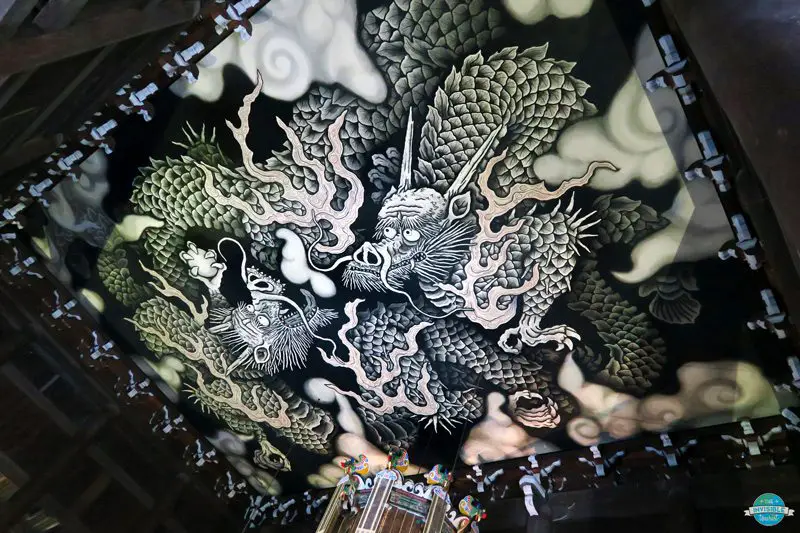
The hand painted dragon is gorgeous to observe at Kennin-ji Temple. Photo credit: The Invisible Tourist
3. See the views of Kyoto from Kiyomizu-dera Temple.
Kiyomizu-dera (清水寺) is a Buddhist temple that was founded in 778. It’s recognized as a UNESCO site for the Historic Monuments of Ancient Kyoto. The temple is located on Mount Otowa so you’ll get some amazing photos of Kyoto city from above.
You can easily spend an hour walking around to see the various places such as the gorgeous vermilion Niomon gate and Saimon west gate. Behind the Saimon gate is the three-storied pagoda which is lovely to see the details up close.
If you need some extra good luck, head to the Otowa Waterfall. Three streams flow down from the roof and they represent three aspects of life – academics, longevity, and relationships. To get your good luck, catch the water from one of the streams and your wish will come true. If you grab water from all three streams, it’s considered being “too greedy” so choose your stream wisely.
The main hall is another good spot to visit as you can see the wooden construction for the observation deck. As of February 2020, the rooftop has finished construction.
Address: 294 Kiyomizu, Higashiyama Ward, Kyoto, 605-0862, Japan (〒605-0862 京都府京都市東山区清水294)
Opening Hours: 6:00am-6:00pm
Admission Cost: 400 yen ($3.70) adults and high school students, 200 yen ($1.90) elementary and junior high students
How to Get There: From Kennin-ji Temple to Kiyomizu-dera, it’s a 20 minute walk for 1.3 kilometers (.80 miles). Or, take Kyoto City Bus #86, 101, 106, 110, or 206 from Kyoto Station to the temple.
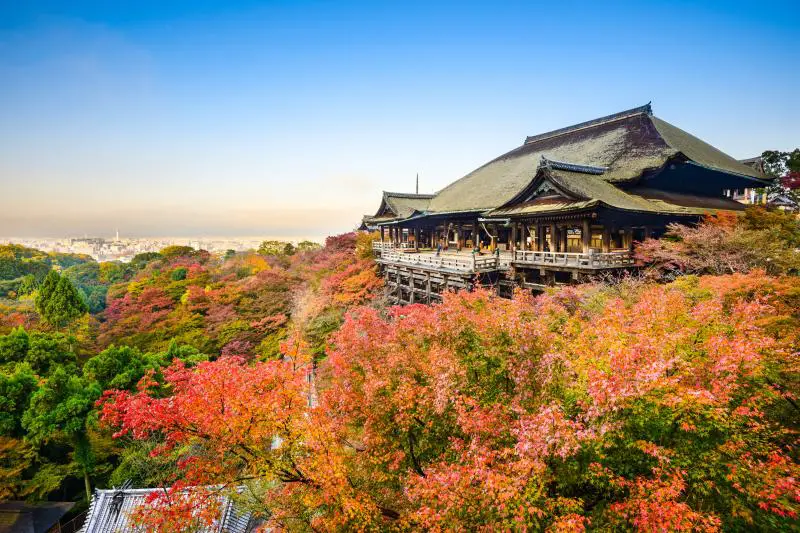
Kiyomizu-dera is a top sight to visit during your Kyoto 5 day itinerary. Photo credit: sepavone via Depositphotos.com
4. Explore Gion neighborhood and visit Hokan-ji Temple (Yasaka Pagoda).
By Greta, Greta’s Travels
If you’re looking for the best things to do in Kyoto, you have to add the Gion neighborhood to your Kyoto travel itinerary. Gion (祇園) is the geisha neighborhood in Kyoto. As you wander around the quaint streets it’s common to see both tourists and locals walking around Gion in kimonos.
Here the streets are mostly pedestrian and lined with low traditional houses. Walking along the streets of Gion feels like stepping back in time. There are also lots of shops, restaurants, and street food stalls where you can purchase some souvenirs or taste Japanese cuisine.
The most famous spot in Gion is without a doubt the pagoda of the Hokan-ji (also referred to as Yasaka Pagoda / Yasaka no tou 法観寺 八坂の塔). This 5-story Buddhist pagoda towers over the low houses and is visible from a distance. It might seem like an odd sunset spot choice as it’s not very panoramic, but watching the streets of Gion light up as the sun goes down, with the pagoda in stark contrast against the fiery sky is a unique experience.
Hokan-ji Temple Address: Japan, 〒605-0862 Kyoto, Higashiyama Ward, 清水八坂上町388 (〒605-0862 京都府京都市東山区清水八坂上町388)
Temple Opening Hours: 10:00am-4:00pm
Temple Admission Cost: 400 yen ($3.70) adults, free under elementary school students
How to Get There: The easiest way to get to Gion is with the public transport either via bus or train. From JR Kyoto Station, take the Kyoto City Bus #86, 100, 106, 110, 206. The closest train stations are Gion-Shijo (祇園四条駅) and Kiyomizu-Gojo (清水五条駅) via Keihan Main Line.
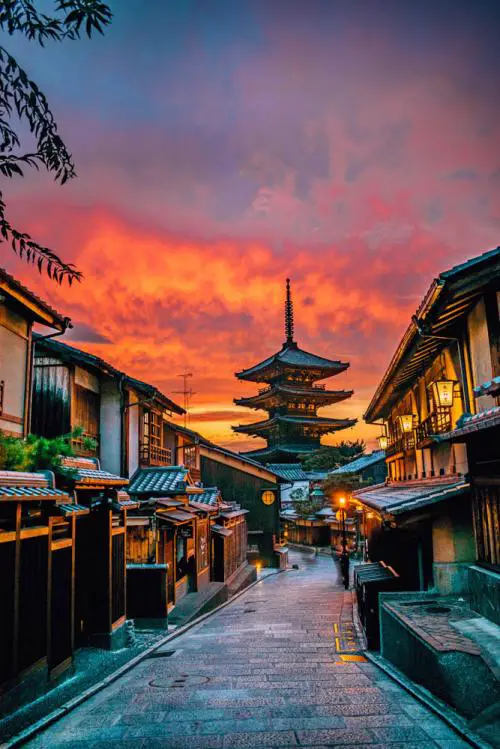
Gion neighborhood is the best spot to visit in Kyoto during sunset. Photo credit: Greta’s Travels
Click here to take a tour of Gion in the evenings.
5. Check out Yasaka Shrine and Chion-Temple.
By Sarah and Justin, Travel Breathe Repeat
Seeing the incredible temples and shrines throughout Kyoto was absolutely a highlight of our Japan 3 week itinerary. There are so many to choose from which can be intimidating. So if you’re struggling with which Kyoto attractions to prioritize, we highly recommend Yasaka Shrine (八坂神社) and Chion-in Temple (知恩院).
These two top Kyoto sights are located in a complex in the Gion neighborhood, so you can easily combine a visit here with that picturesque area of the city. Yasaka Shrine (also known as the Gion Shrine) follows the Shinto religion and was built in 656. It’s dedicated to the Susanoo god. Chion-in Temple is the main temple for Jodo Buddhism and has an iconic Sanmon main gate.
Give yourself at least a couple of hours to peacefully explore everything there is to see in this beautiful area of the city. There are gardens and paths to meander through. Also, stop by Maruyama Park which is famous for its cherry blossoms in April.
Address:
- Yasaka Shrine: 625 Gionmachi Kitagawa, Higashiyama Ward, Kyoto, 605-0073, Japan (〒605-0073 京都府京都市東山区祇園町北側625)
- Chion-in Temple: 400 Rinkacho, Higashiyama Ward, Kyoto, 605-8686, Japan (〒605-8686 京都府京都市東山区林下町400)
Opening Hours:
- Yasaka Shrine: Available 24 hours
- Chion-in Temple: 9:00am-4:30pm (last admission at 3:50pm)
How to Get There: They are located about a 10-minute walk from a few subway stations. If you want to visit the Yasaka Shrine first, take the train to Gion-Shijo Station (祇園四条駅) via Keihan Line or Kawaramachi Station (京都河原町駅) via Hankyu Line. If you want to visit Chion-In Temple first, take the train to Higashiyama Station via Tozai Line (東山駅).
Tip – If you start at Yasaka Shrine and end at Chion-In Temple, you’ll avoid climbing an enormous flight of stairs.
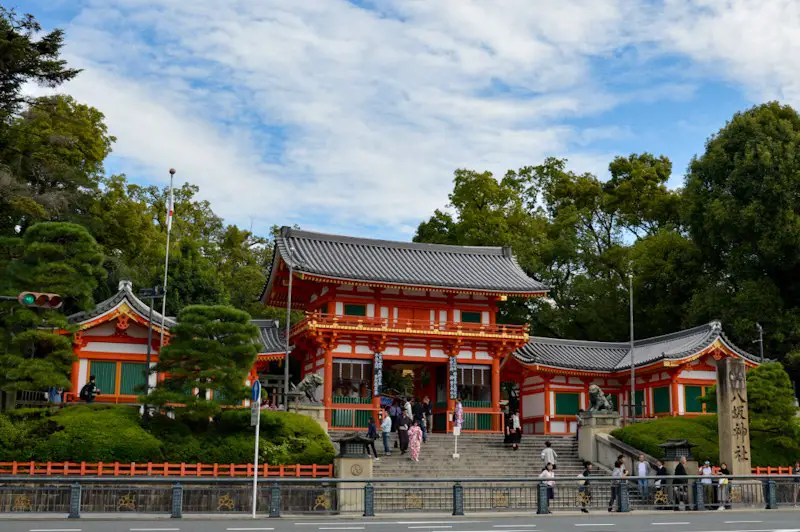
Yasaka Shrine is a top highlight when you’re in the Higashiyama area. Photo credit: Travel Breathe Repeat
Kyoto Itinerary Day 2: Ginkaku-ji and Fushimi Districts
On your second day in Kyoto, we’re returning to the north Higashiyama district, specifically the Ginkakuji area as our first day was jam-packed with sightseeing. Afterward, we’ll head to the Nishiki Market and then south to the Fushimi Inari Shrine.
1. Wander through Heian Jingu Shrine.
By Tanja, Ryokou Girl
Heian Jingu Shrine (平安神宮) in the Higashiyama district is home to some of the most beautiful traditional gardens in Kyoto. You’ll find them less crowded than other shrines and temples making it the perfect tranquil spot away from the noisy city. This Shinto shrine was built in 1895 and the entrance is marked by the appearance of the giant 25 meters (82 feet) high red torii gate.
The four landscaped gardens have been designated a National Site of Scenic Beauty in Japan and are also one of Kyoto’s top spots for cherry blossoms in early April. Heian Jingu was also used as a filming location in the movie, “Lost in Translation,” where Scarlett Johansson’s character explores the gardens and crosses the pond using the famous stepping-stones.
It’s easy to spend at least an hour walking around the grounds spotting wildlife to include turtles, butterflies, and herons.
For updated information on the temple, check out their Twitter.
Address: Okazaki Nishitennocho, Sakyo Ward, Kyoto, 606-8341, Japan (〒606-8341 京都府京都市左京区岡崎西天王町)
Opening Hours: 6:00am-5:00pm
Admission Cost: Entry to the gardens at Heian Jingu costs 600 yen ($5.60) per person
How to Get There: It’s a 10-minute walk from Higashiyama Station (東山駅) via Tozai Line. You can also take the Kyoto City Bus #5, 100, and 110 from Kyoto Station to the temple.
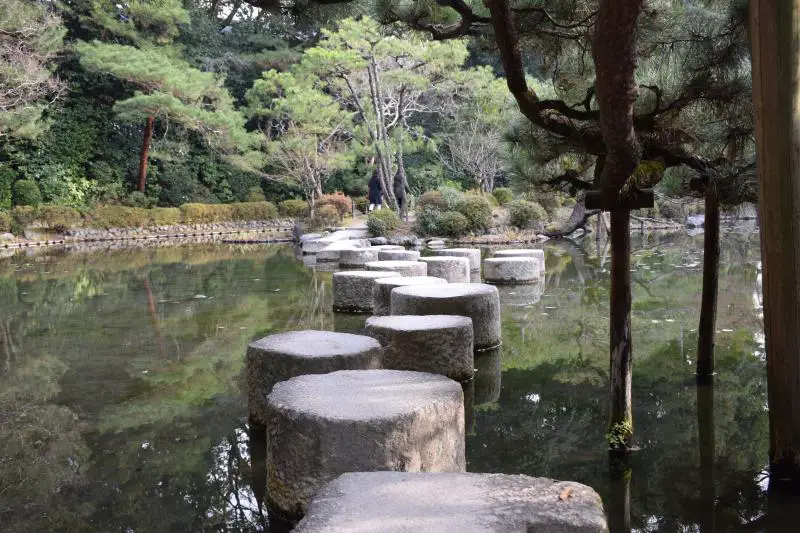
Want to walk across the stepping stones at the Heian Jingu Shrine? Photo credit: Ryokou Girl
2. Walk along the Philosopher’s Path.
By Cassie, Cassie the Hag
Strolling along the Philosopher’s Path has to be one of the most peaceful activities in Kyoto. At 2 kilometers (1.2 miles) long, the main walk begins at Ginkaku-ji (銀閣寺), a temple with beautiful moss-covered gardens and views over Kyoto, and ends at Nanzen-ji (南禅寺). Nanzen-ji is also distinctive, with a series of red brick arches within the temple grounds.
The Philosopher’s Path itself is a stone footpath following alongside a canal. It’s a pretty and peaceful walk and named after Nishida Kitaro, a philosopher who once came to the area for meditations. You can also combine the path with a longer walk continuing to the Gion district. If you start early enough, go temple hopping to Kiyomizu-dera (清水寺) for its stunning red-orange pagoda.
During the cherry blossom season, it’s a popular place to view the blossoms. If traveling in a shoulder season, you may discover you’re the only person around, making it a romantic spot for couples or a calming place for solo travelers to Japan to reflect on their journey.
Address to Ginkaku-ji Temple: 2 Ginkakujicho, Sakyo Ward, Kyoto, 606-8402, Japan (〒606-8402 京都府京都市左京区銀閣寺町2)
Admission Cost: The Path is free. Ginkaku-ji has a 500 yen ($4.70) admission cost for adults and high school students and 300 yen ($2.80) for elementary and junior high students.
How to Get There: Take the Kyoto City Bus #5, 17, or 100 from Kyoto Station to the Ginkaku-ji Temple to begin the walk. Or, take Kyoto City Bus #5, 32, or 100 from Heian Jingu Shrine.

The Philosopher’s Pass is a great place to take a walk when you’re in Kyoto. Photo credit: Cassie the Hag
3. Navigate through Nishiki Market.
By Anne, Pretraveller
Nishiki Market (錦市場) is an essential experience when visiting Kyoto as it’s one of the top foodie markets in Japan. It’s a free open covered market centered around a long and narrow five-block shopping street that is surrounded by hundreds of food-related shops and restaurants. Nishiki Market specializes in local produce and offers a vast range of experiences. Many shops offer free samples, or you can purchase to eat straight away – not forgetting that you should not walk and eat in Japan!
To make the most of your Nishiki Market experience, you should plan to visit on a weekday as weekends are much busier. Booking a food tour is a great way to learn more about the Kyoto area’s produce and traditions and to try the local specialties.
To get through Nishiki Market, plan to start at one end and browse through to the other end – ensure you allow 2-3 hours so you can enjoy the experience.
Address: 609番地 Nishidaimonjicho, Nakagyo Ward, Kyoto, 604-8054, Japan (〒604-8054 京都府京都市中京区西大文字町609番地)
Opening Hours: Most stores are open seven days per week, typically from 9:00am to 6:00pm
How to Get There: The closest stations are Shijo Station (祇園四条駅) via the Karasuma Line or Kawaramachi Station (京都河原町駅) at the eastern end and Karasuma Station (烏丸駅) at the western end of the market street via Hankyu Line. There are also many bus options to get around the area.
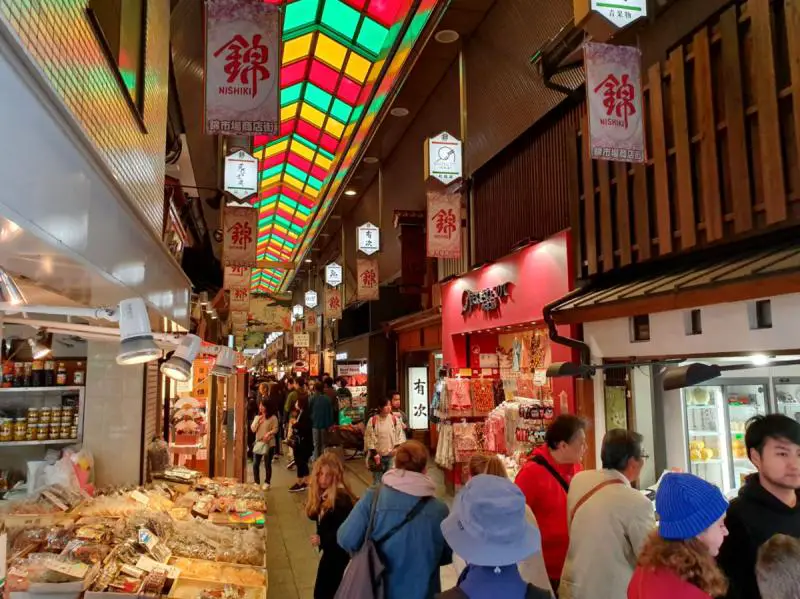
Nishiki Market is the best place to visit in Kyoto to try new foods and snacks. Photo credit: Pretraveller
4. Walk through Fushimi Inari Taisha Shrine.
Fushimi Inari Taisha (伏見稲荷大社) is a famous places in Kyoto. This Shinto shrine is dedicated to Inari, the god of rice. The shrine has kitsune (foxes) statues and decor everywhere as they’re messengers. They are depicted with a key in their mouths.
When you enter the temple area, the main hall is where visitors go to pray. In the same area, there are smaller shrines. We passed by one which had rows of colorful origami paper cranes strung together on the walls.
The main attraction of Fushimi Inari Taisha is to walk through 10,000 vermilion torii gates or at least a portion of the gates. The walking route is straightforward as you follow the path of the torii and there aren’t too many hills to conquer.
If you prefer to take a hiking tour, consider this option.
The beginning of the walk is crowded with people but the crowds taper off as you get farther from the main entrance. It’s a good thing since you can get better photos in the non-crowded spots!
During your walk, you’ll embrace the tranquility and the quietness of the mountains and smell the fresh air. You’ll pass by smaller shrines which will have different size torii gates and kitsune statues.
If you have the chance to do the full walking path loop, you’ll reach the summit of Mount Inari at 233 meters (764 feet). The round-trip walk can take around 1.5-2 hours depending on your speed. Don’t expect any landmark to depict the top of the mountain. Instead, you’ll see a small sign in front of a shrine that says that you’ve reached the top and the height of the mountain.
You can visit the shrine and walk the path at any time. While we recommend going in the early morning, we’ve also visited in the late afternoon around sunset. Both times provide fantastic photo opportunities.
Address: 68 Fukakusa Yabunouchicho, Fushimi Ward, Kyoto, 612-0882, Japan (〒612-0882 京都府京都市伏見区深草藪之内町68)
How to Get There: Take the train to the JR Inari Station (稲荷駅) and cross the street to get to Fushimi Inari Shrine.
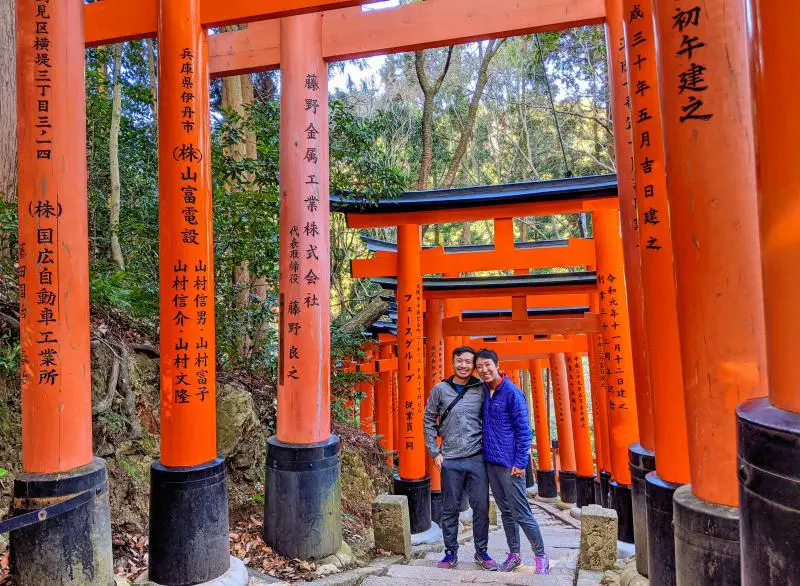
The torii gates at Fushimi Inari Taisha are impressive to see in person.
5. Hang out at Kyoto Station at night.
Surprisingly, Kyoto Station is a fun and unique place to visit in Kyoto at night! It’s recommended to explore the station in the evening as there are many attractions to see. You’ll need to exit from the north side which has the Kyoto Tower in order to see these places.
The highlights include:
- Check out the Big Staircase as it has illuminating lights and music. The impressive staircase has 125 steps with over 15,000 LED lights. The showing times are 3:00pm-10:00pm. During our visit, there were Valentine’s Day messages. The staircases had plenty of “I Love You” and heart messages.
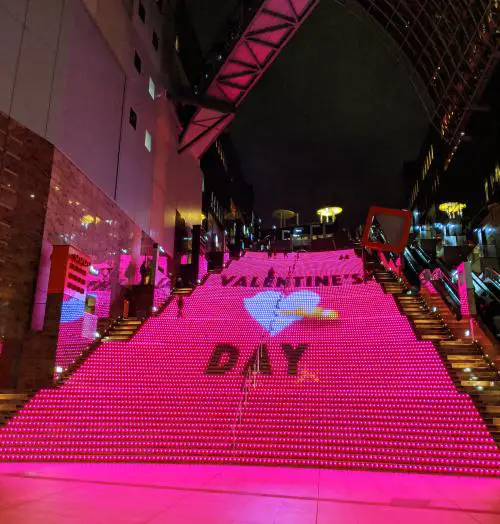
Check out Kyoto Station’s Big Staircase in the evenings. It’s a highlight on your Kyoto itinerary.
- Take an evening walk along the Star Bridge. This walkway is dark and only lit with the colorful lights on the perimeter of the walkway. Since the walkway is 45 meters (148 feet) above the ground, you’ll have some pretty views of the glowing Kyoto Tower. Opening hours: 5:00pm-10:00pm
- Ride the neverending escalators to the rooftop of the Sky Garden. From there, you can get a night view of the city and a partially covered view of the Tokyo Tower. Otherwise, it’s a good hangout spot to relax after your day of visiting Kyoto tourist attractions.
- Feel like a princess at the lit gazebo in the Luna Garden in the East side of the plaza. Opening hours: 5:00pm-10:30pm
- If you’re hungry, check out Kyoto Ramen Koji on the 10th floor of the station. Ramen lovers will enjoy trying 9 different famous ramen shops from various regions – Hakata, Kitakata, Kyoto, Nagoya, Osaka, Sapporo, Tokushima, Tokyo, and Toyama. Opening hours: 11:00am-10:00pm
Read our ramen adventures in Fukuoka here.
Address: Higashishiokoji Kamadonocho, Shimogyo Ward, Kyoto, Japan (京都府京都市下京区東塩小路釜殿町)
Kyoto Itinerary Day 3: Arashiyama District
On the third day in Kyoto, we’re headed to the Arashiyama (嵐山) district which is on the western side of the city. It’s a mountainous area that has a mix of traditional shrines and temples along with nature and wildlife.
1. Awe at Arashiyama Bamboo Forest.
The Bamboo Forest (嵐山 竹林の小径) is a bucket list place to visit in Kyoto. You’ve seen this area splashed over social media with thousands of tall bamboo clustered in a tranquil forest area.
This is the first spot that you’ll want to visit in the Arashiyama district. It’s a serene spot to enjoy some nature and take photos. You may even see some engagement proposals and wedding photography take place here. The path isn’t very long so it’ll take about 10 minutes to walk through, plus some extra time for photos.
Since it’s a popular place in Kyoto, this area gets very crowded. Many of the photos depict an empty forest area but you’ll need to get there early in the morning (before 7:00am). Otherwise, set the expectation that you’ll have people photobombing your photos. The one area that we found wasn’t as crowded was towards the back of the Tenryu-ji Temple area.
Address: Ukyo Ward, Kyoto, 616-0000, Japan (〒616-0000 京都府京都市右京区)
How to Get There: The Bamboo Forest is next to the Tenryu-ji Temple. The closest train station is Torokko Arashiyama Station (トロッコ嵐山駅) via the Sagano Scenic Line or JR Sanin Main Line, Arashiyama Station (嵐山駅) via Randen Arashiyama Line, or Saga-Arashiyama Station (嵯峨嵐山駅) via JR Sanin Main Line.
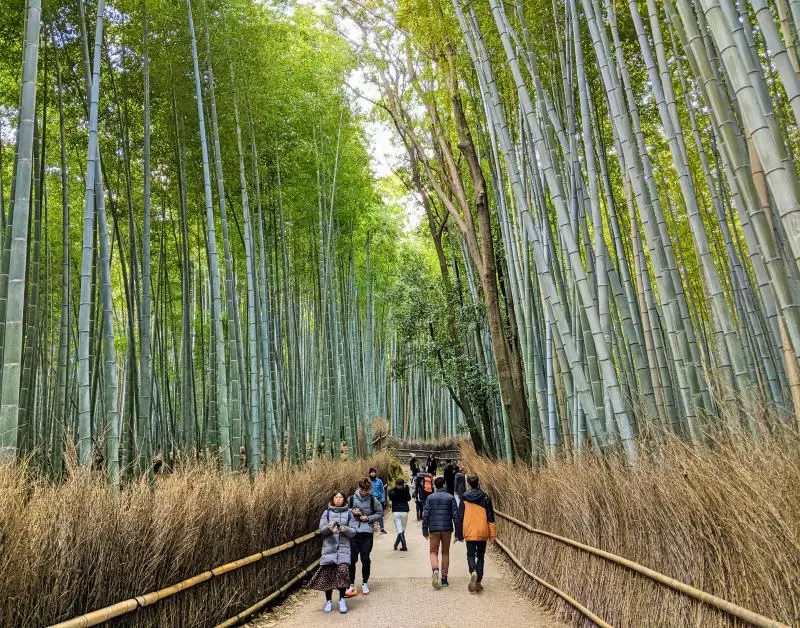
Arashiyama Bamboo Forest is a popular photo spot when you’re in Kyoto.
Read More: Check out other Bamboo Forests in Beppu and Kamakura, Japan.
2. Visit Tenryu-ji Temple.
Tenryu-ji Temple (天龍寺) is recognized as one of the UNESCO’s Historic Monuments of Ancient Kyoto. Established in 1339, this temple has historical significance with Zen Buddhism and is considered the oldest Zen temple in Kyoto (along with Kennin-ji Temple which we’ll share more below). Although the temple has experienced many fires, it’s been restored to what it looked like in the past.
What we love about Tenryu-ji Temple is the peace and calmness of the area. The temple has beautiful garden areas with seasonal plants and a manicured rock garden. You can take a small hiking path up the mountain to see an aerial view of the temple’s rooftop and temple grounds. The must-see place at the temple is the Sogenchi Teien (Sogen Pond Garden) as the pond overlooks the mountains. The pond has large koi swimming around.
If you’re interested in seeing more of the temple’s architecture and history, you can walk inside the temple building for an additional fee.
The temple has a special exhibit which features a Cloud Dragon on the ceiling of the Hatto lecture hall. The black and white dragon artwork commemorating the anniversary of the death of Muso Kokushi, Tenryu-ji’s founder. This exhibit is available on the weekends and holidays.
For temple updates, check out their Twitter page.
Address: Japan, 〒616-8385 Kyoto, Ukyo Ward, Sagatenryuji Susukinobabacho, 68(〒616-8385 京都府京都市右京区嵯峨天龍寺芒ノ馬場町68)
Opening Hours:
- Garden and Building: 8:30am-5:00pm
- Dharma Hall: 9:00am-4:30pm for summer, 9:00am-4:00pm for winter
Admission Cost:
- Garden only: 500 yen ($4.70) adults and high school students, 300 yen ($2.80) elementary and junior high students
- Garden and Building: 800 yen ($7.50) adults and high school students, 600 yen ($5.60) elementary and junior high students
- Hatto: An additional 500 yen ($4.70) to the general admission as it’s a special exhibit fee
How to Get There: Follow the instructions above from the Bamboo Forest for the nearest train stations.
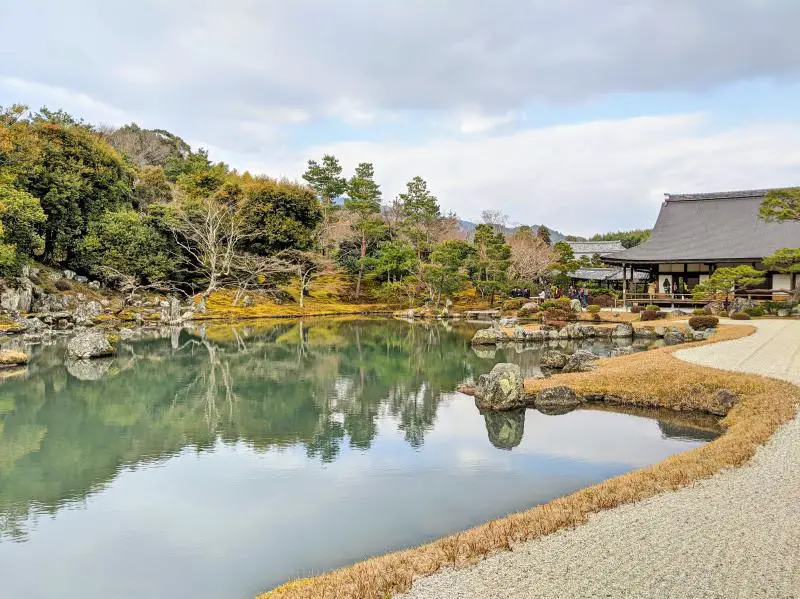
Tenryu-ji Temple and garden are peaceful to walk through.
3. See adorable monkeys at Arashiyama Monkey Park Iwatayama.
By Melissa, Thrifty Family Travels
For lovers of cute little monkeys, a visit to Monkey Park Iwatayama (嵐山モンキーパークいわたやま) is an absolute must! Monkey Park is home to over 170 wild Japanese macaque monkeys and is particularly a great attraction to visit for those visiting Kyoto with kids.
The monkeys are adorable to watch and they roam free which is wonderful. In fact, humans are the ones in the cage! You can roam around the park while keeping a healthy distance away from the monkeys. If you want to get up close with them, there is a building you can enter which is like a cage. From here the monkeys come up real close to you.
Given Monkey Park is on the top of a hill, there are also fantastic views across Kyoto from here. Other facilities include a small shop selling snacks and drinks and a small playground (not a very good one though).
Word of warning – You need to walk up a very steep hill to reach Monkey Park and if it’s during the warmer months expect the temperatures to be hot. Bring plenty of water with you for the walk.
Check out their Twitter to see updates on the park.
Address: Japan, 〒616-0004 Kyoto, Nishikyo Ward, Arashiyama Nakaoshitacho, 61 (〒616-0004 京都府京都市西京区嵐山中尾下町 61)
Opening Hours: 9:00am-4:00pm
Admission Cost: 550 yen ($5.10) adults and high school students, 250 yen ($2.30) children (4+ years to junior high students)
How to Get There: The nearest train station is Arashiyama (嵐山駅). From the station, it’s 550 meters (.34 miles) to reach the base of the mountain. You’ll need to cross the Togetsukyo Bridge.
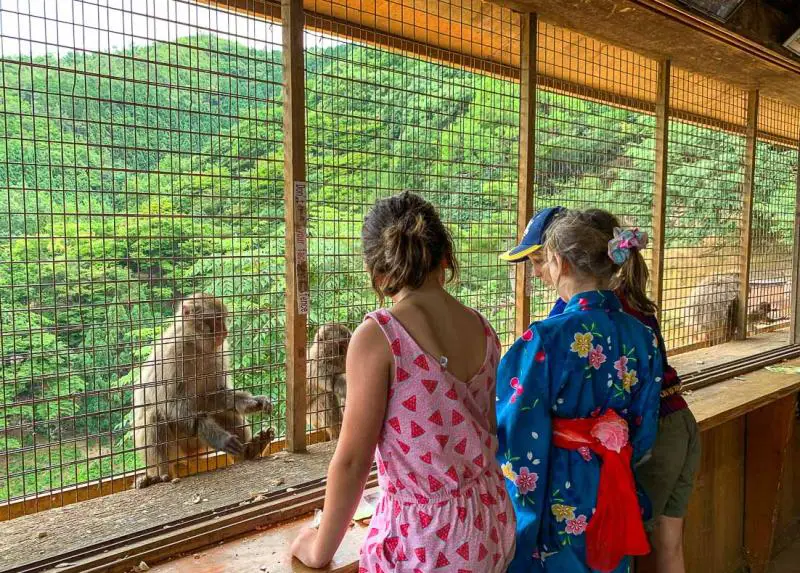
Observe monkeys in their natural habitat at Arashiyama Monkey Park Iwatayama when you’re in Kyoto. Photo credit: Thrifty Family Travels
4. Visit the Little Stone Men at Otagi Nenbutsu-ji.
By Anna, My Travel Scrapbook
The little stone men in the outer Arashiyama area must be on your things to do list in Kyoto! As an off-the-beaten-path spot, few tourists venture to see them as they lie deep in the forest away from the main tourist sites.
The little stone men of Kyoto stand in a woodland temple at Otagi Nenbutsu-ji (愛宕念仏寺). They’re covered in moss as if they’re spirits who have been here for centuries. In fact, they’re less than 50 years old. All 1,200 rakan, known as Buddha’s followers, were carved out in the 1980s. They’re all individuals and have their own personalities. Some are drinking sake whereas others are about to play tennis.
The whole site is wonderful and the woodland setting adds to the magical atmosphere.
Address: 2-5 Sagatoriimoto Fukatanicho, Ukyo Ward, Kyoto, 616-8439, Japan (〒616-8439 京都府京都市右京区嵯峨鳥居本深谷町2-5)
Opening Hours: 8:00am-4:30pm
Admission Cost: 300 yen ($2.80) adults, free under 15 years
How to Get There: There are four options to consider to get to the temple:
- It’ll take about 25 minutes on foot from the heart of Arashiyama.
- Hire a bike and cycle to the temple.
- Take a taxi from anywhere in the city.
- Another option is to take the bus. Walk 10 minutes from JR Saga-Arashiyama Station (嵯峨嵐山駅) to Nonomiya bus stop and take the Bus #62, 72, 92, or 94 bound for Kiyotaki. Get off at Otagi-dera mae bus stop which is in front of the temple.
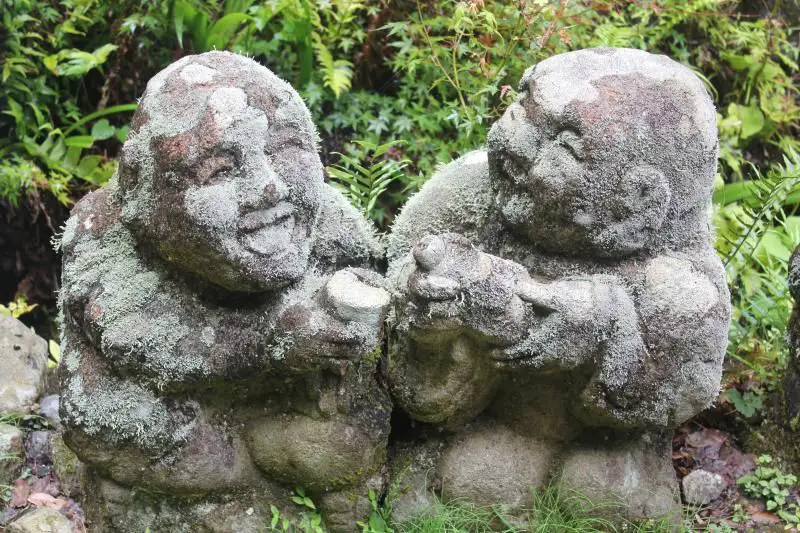
These little stone men are adorable to check out when you’re in Kyoto’s Arashiyama area. Photo credit: My Travel Scrapbook
Read More: Check out more rakan at Miyajima Island and Kawagoe.
5. Eat and shop along the main street.
After seeing the major sights in Arashiyama, you probably want a short break. The main street, Sagatenryuji Susukinobabacho, is the perfect place to unwind with shopping and eating. There are a variety of boutique and souvenir shops selling souvenirs and lots of snack shops. You can even hire a rickshaw and the driver will take you to more highlights of Arashiyama.
One of the unique foods that we’ve eaten in Kyoto is the yuba (beancurd skin) and matcha green tea soft serve. You’ll see several shops skimming the tops of the simmering beancurd to get the thin layer of yuba every few minutes. The yuba flavor is subtle and perfectly complements the matcha green tea. Don’t worry, it won’t taste like you’re eating tofu. We paid 300 yen ($2.80) for the ice cream.
As for souvenirs, we suggest that you buy yatsuhashi (八ツ橋). It’s a Japanese sweet made from glutinous flour and typically has red bean flavors and folded into a triangle shape. We personally call it a triangle mochi and love the texture and flavors.
Try the yatsuhashi at Izutsu Yatsuhashi Honpo at Arashiyama Station (井筒八ツ橋本舗 嵐山駅店). This sweets company was established in 1805 and continues to bring delicious sweets to locals and visitors. There are many locations in Kyoto. During our visit, there were fun flavors for the yatsuhashi such as black sesame, green tea, cinnamon, and chocolate.

Izutsu Yatsuhashi Honpo is a famous shop in Kyoto that sells yatsuhashi sweets. It’s a delicious souvenir to buy in Kyoto!
6. Stop by the Kimono Forest that connects to the Arashiyama Station.
In the back of the Arashiyama Station is the not so crowded Kimono Forest (キモノフォレスト), also referred to as the “Forest of Light.” It’s a warm and welcoming walkway that has 600 poles with colorful prints from flowers, birds, and other Japanese patterns that you’ll see on a kimono. They light up in the evening, which we regretfully haven’t seen yet. From other visitors’ photos, the evening view looks gorgeous.
Address: 35-28 Sagatenryuji Tsukurimichicho, Ukyo Ward, Kyoto, 616-8384, Japan (〒616-8384 京都府京都市右京区嵯峨天龍寺造路町35-28)
Kyoto Itinerary Day 4: Uji
On your fourth day in Kyoto, we’re going to an underrated area of Kyoto, Uji (宇治). Located south of Kyoto, Uji is the best day trip to experience if you want to experience the countryside and also see where Kyoto famously grows some of their tea (matcha, sencha, hojicha, etc.)
If you love eating and drinking matcha or green tea flavored foods and drinks, then you’ll have no problem eating your way through Uji. Try matcha soba, mochi, ice cream, pudding, dumplings, and more. You’ve probably never seen so much green food in one day. We think eating matcha desserts provide a stronger matcha flavor versus matcha noodles.
The main highlight of visiting Uji is Byodoin Temple (平等院). This Buddhist Temple is on the back of the 10 yen coin. This temple has a museum, garden area, and the Phoenix Hall which houses a statue of Amitabha Tathagata (Buddha). Before heading to the temple, wander around the Byodoin Omotesando Street. which is the main shopping street to buy souvenirs and also try and purchase tea.
You can easily walk through the town to see other temples and shrines and enjoy the peacefulness of the area.
How to Get There: From the Kyoto Station (京都駅), take the JR line to Uji Station (宇治駅) via the JR Nara Line. The ride will take 30 minutes.
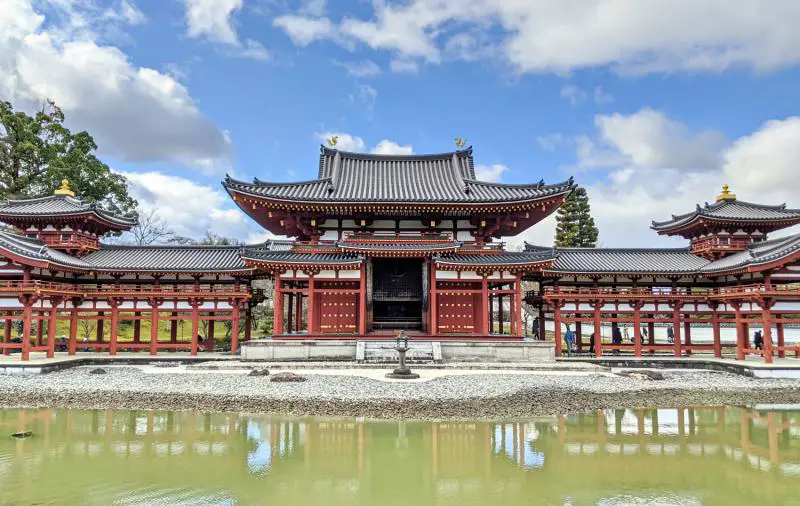
Byodoin Temple’s Phoenix Hall is a picturesque area to explore during your day in Uji.
Kyoto Itinerary Day 5: Free Day
For your fifth day in Kyoto, you can do whatever you’d like! You have the option to revisit areas that you missed on the first few days, take a day trip from Kyoto, or try new experiences. We’ll share several options to take below.
1. Say hello to the Nara deer.
Nara is the perfect day trip from Kyoto where you can see deer up close. The deer wander around the parks and temples and will be extra friendly (sometimes aggressive) with you if you have the special “deer crackers.” There are also beautiful temples and shrines to visit such as Todai-ji, Kofuku-ji, and Toshodai-ji. We haven’t written about Nara yet, but will share our experiences in the future! While you can visit Nara on your own, click here for a tour option.
How to Get There: From Kyoto Station, take the JR Nara Line to go to Nara Station (奈良駅). It’ll take 1 hour and 10 minutes as it’s a local train route.
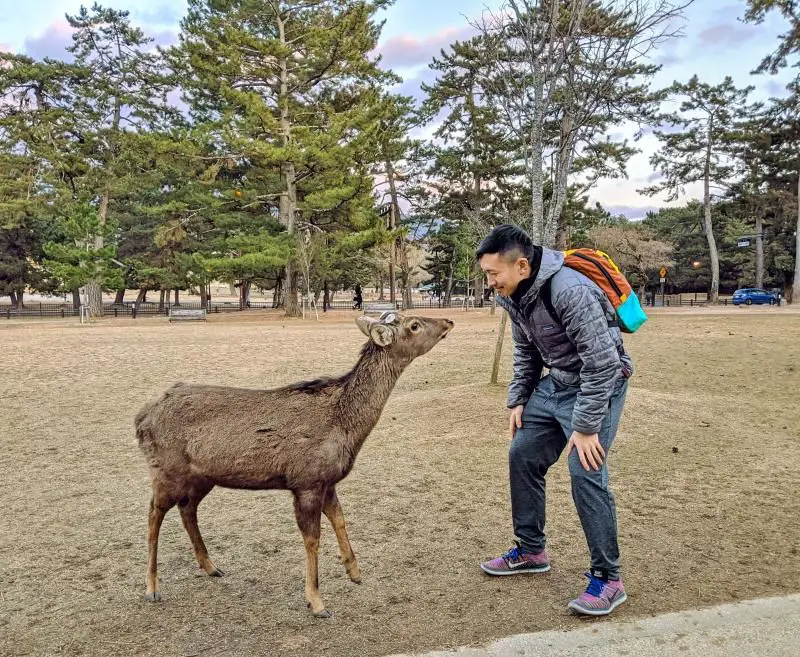
Nara is a fun day trip from Kyoto to see wild deer.
2. Explore Himeji to see Himeji Castle.
Most visitors visit Himeji in one day to see the Himeji Castle. It’s an impressive castle due to its white exterior and 17th century architecture. Visitors get the opportunity to walk inside the castle and see the 7 floors of the main Keep (the main building). The area is also lovely to walk around to see views of Himeji City.
Another highlight of Himeji is visiting Koko-en Garden. It’s technically on the Himeji castle grounds but there is a different location for the entrance and a separate admission fee.
How to Get There: From Kyoto Station, take the shinkansen to Shin-Osaka Station. Transfer to another shinkansen train to go to Himeji Station (姫路駅). Allocate 1 hour and 2 minutes. Or, take the JR Tokaido-Sanyo rapid line to Himeji Station. It’ll take 1 hour and 30 minutes.
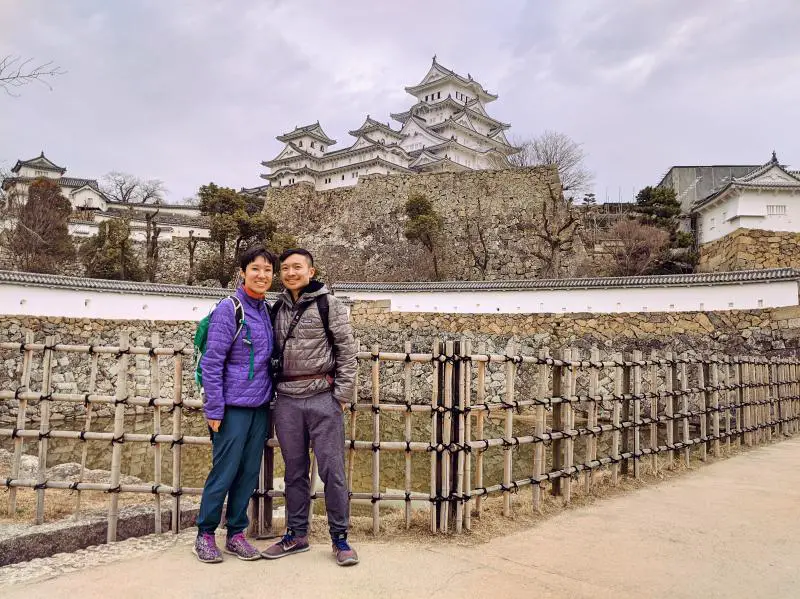
During your Himeji day trip, check out this postcard perfect photo spot in Himeji Castle.
3. Visit the neighboring city, Osaka.
While Kyoto exemplifies traditional architecture and values, Osaka is a modern and vibrant area. Osaka in one day isn’t ideal, but you can spend your time seeing Osaka Castle, eating lots of street food (ie: takoyaki and okonomiyaki) and cheap foods, and shopping. Dotonbori is a highlight as it’s Japan’s version of Las Vegas (minus the gambling) with the bright shiny lights and huge signs of food products.
How to Get There: From Kyoto Station, take the shinkansen to Shin-Osaka Station (新大阪駅), and then take a local train to Osaka Station (大阪駅). Or, take the JR Tokaido-Sanyo rapid line heading to Himeji to Osaka Station. The trip will take 30 minutes for either route.
4. Check out these other places in Kyoto to explore or add to your Kyoto bucket list.
- Visit Kinkaku-ji Temple (金閣寺) to see the Golden Pavilion zen temple in the Kita area.
- Tour Kyoto Imperial Palace and Nijo Castle.
- Experience a photo shoot wearing a kimono.
- Learn how to make ramen.
- Hike Kurama Mountain and visit a hot spring.
Where to Stay in Kyoto
With a variety of accommodation options, there are many incredible places to stay in Kyoto. Depending on your travel budget, you can choose to stay at ryokans, guesthouses, or hotels. We’re sharing options below and also including the average pricing per night for 2 person occupancy in U.S. currency.
Book your Kyoto accommodations here.
Stay in a Ryokan.
By Sarah, A Social Nomad
Kyoto is one of the most traditional places in Japan that most tourists will visit and there is no better way to stay than in a traditional Japanese inn, a ryokan. While you can find these ryokans throughout the country, some of the best are found in Kyoto.
A traditional stay in a ryokan includes staying in a room with paper walls, tatami mat flooring, and sleeping in a futon on the floor. All are comfortable and an incredible cultural experience. The other elements of staying in a ryokan are to wear traditional yukata and to take your meals in your room. The best ryokans provide specialty cuisine tailored specifically to Kyoto’s natural resources.
We recommend staying in some of the best ryokans that Kyoto has to offer. Ryokan stays are bucket list experiences, so why not splurge! Here are three recommended ryokans:
- Luck You Kyoto Bukkoji-Higashimachi (Average cost per night: $120-$200 per night)
- Gion Komatsu which has with private bathrooms (Average cost per night: $310 per night)
- Ryokan Izuyasu which was built in 1839 (Average cost per night: $360-$630 per night)
You may be able to book a room with private bathing facilities, but the communal (gender separated) bathing facilities are also great fun and a fabulous experience.
Kyoto Hotel Options
We’ve stayed at two different places in Kyoto – a guesthouse and a hotel. Both are recommended depending on your preference with accommodation style.
Riraso Guesthouse
Riraso Guesthouse is an apartment-style guesthouse that is great for a few days. There are two rooms – one with a bed and one with tatami mats for up to a four-person occupancy. It will be a tight squeeze with four-people, yet it’s doable. The bed is really comfortable so you’ll feel refreshed in the morning. We used the room with the tatami mats as a place to enjoy snacks and to hang out. The apartment comes with a stovetop and microwave to do some light cooking and also has an ensuite bathroom with shampoo and body wash.
While the guesthouse is not in the main central area of Kyoto, it’s less than a 10-minute walk from the Nishioji Station (西大路駅) and Kyoto Station is only one stop away. The average cost per night is $74 for a 2 person occupancy. It’s a two-night requirement for the stay.
Book a room at Riraso Guesthouse today.
Westin Miyako Kyoto
The Westin Miyako Kyoto is a luxurious hotel to stay in the Higashiyama area. It’s not in the main tourist area so it’s quiet. You will need to walk up a hill to get to this hotel but it’s worth the effort as the hotel has breathtaking views of the forest. The recently renovated hotel is within walking distance to Keage Station (蹴上駅). Everything is up to the Westin standard with comfortable beds, bathroom amenities, and great customer service from the workers.
We stayed here before it was renovated and used credit card points to redeem a room. Otherwise, this hotel is on the splurge side with the average cost per night is $600-$1200 per night for a 2 person occupancy. If we win the lottery, we’ll stay in this room again.
Book a room at Westin Miyako Kyoto here.
Final Thoughts about Kyoto
Kyoto in 5 days is a good amount of time to explore the best of Kyoto. We hope you’ve enjoyed Kyoto’s tranquility ambiance when walking through quiet neighborhoods and charming pagodas. This is one city where we can return to over and over again and see something new and exciting each time.
If you plan to continue through Japan, check out our other Japan articles:
- Spend the day in Okayama
- Explore Naoshima Island in one day
- Spend 2 days in Hiroshima
- Go hiking in Japan
Enjoyed this Kyoto travel guide? If you have questions about this itinerary, ask a question in the comment section.
Save this post to your Japan Pinterest board.
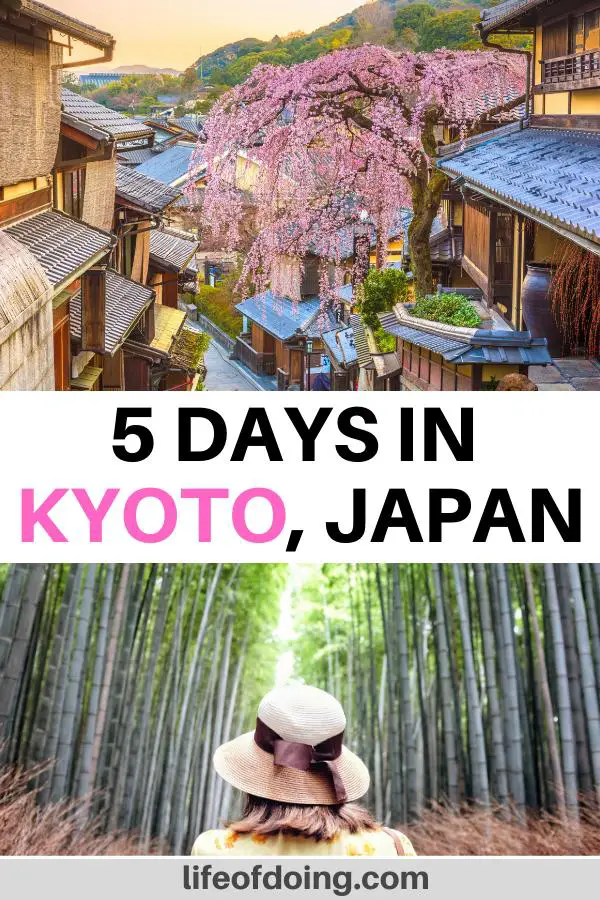 |
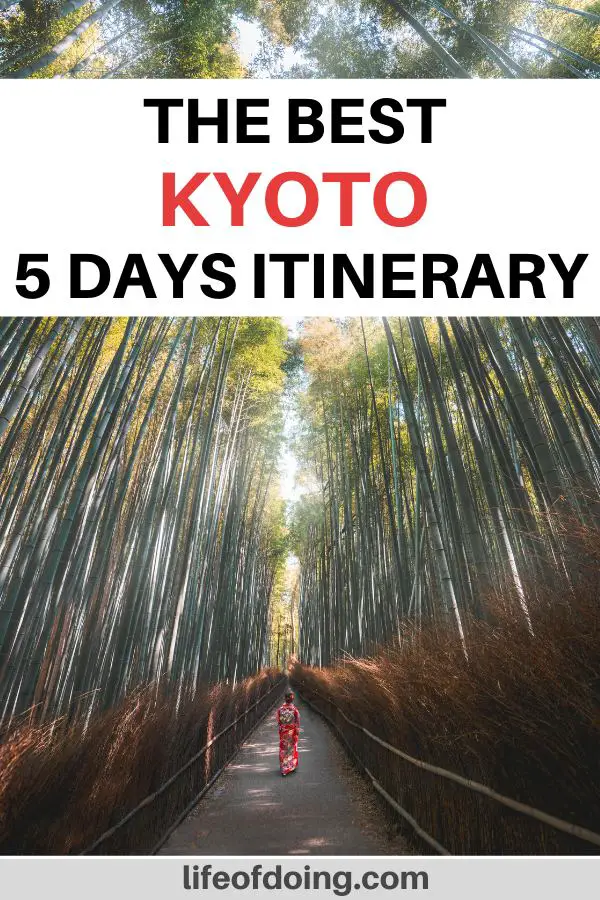 |
Pin #1 bottom photo credit: Luis Alberto Padilla González via Scopio Photos
Featured photo credit & top of pin #1 photo credit: sepavone via Depositphotos.com
Pin #2 photo credit: Jazper Ong via Scopio Photos

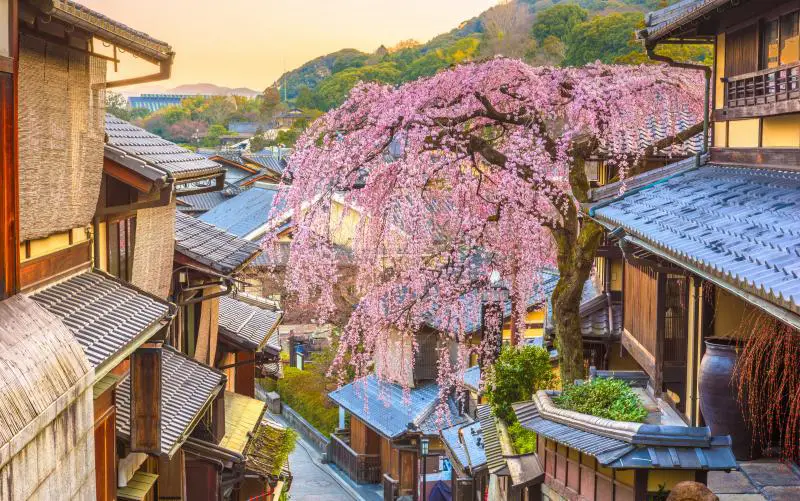
16 comments
Kyoto is one of the places on my bucket list for sure! I love this collection of things to see. And I like the idea of riding a bike around and seeing things from a different view. Also, now I’m really craving ramen!
Hi Laura! It’s close to dinnertime so ramen sounds good right now. Glad you enjoyed reading more about Kyoto.
I love your Japan posts, they always make me so eager to finally visit Japan. My partner was there in 2015, but only got a few days on each end of a business trip to Tokyo. He did quick trip to Kyoto though and fell in love with the city, he still raves about Nishiki Market. Hopefully we can go together next year 🙂
Thanks Derek! It’s great to hear that your partner had the chance to visit Kyoto as a side trip from Tokyo. Hope you can visit Japan next year after everything settles down.
Kyoto is so beautiful! I was only there for a day (a few hours, actually) as part of a weekend trip to Osaka from Seoul and didn’t get to see much apart from Fushimi Inari. I really hope I can return for a longer time and visit the market as well!
Even though you had a short trip day trip to Kyoto, it looks like you have some good memories from the visit. Hope you can come back for a longer visit!
Kyoto was my favourite city when we went to Japan but we for sure didn’t spend five days there due to lack of time. I have yet to see Yasaka shrine as it was part of our itinerary but never got the chance to see it 🙁 We did stay in a ryokan when we were there, though! It was an amazingly beautiful experience and highly recommended, though it was a bit pricey.
Hi Justine. There is too much to explore in Japan and not enough time! It’s awesome to hear that you stayed at a ryokan in Kyoto. We experienced a ryokan in Koyasan and it was a fabulous experience.
Kyoto looks like a great destinaton. I haven’t made it to Japan yet, but hope to make it there one day. Himeji Castle looks great, I always love admiring architecture and I would love to visit with the Nara deer. One day I hope to have the ability to stay in a luxury hotel like Westin Miyako Kyoto, even if I only do it once.
Thanks for stopping by Melissa! Hope you get the opportunity to visit Japan in the future.
It didn’t really occur to me that Kyoto is a good place to explore by bike. I would have opted for walking all the time but that can get tiring so you’re right, biking is a great option to soak in the beauty of Kyoto but also not get too tired. 🙂 We were only there for two days when we went so maybe next time we’ll stay longer and take note of your tips in here 🙂
Yes! I’m thrilled that Clemens from Travellers Archive recommended using a bicycle to explore Kyoto. Such a fun way to see sights and not have to worry about waiting for a bus or train.
I always want to walk through a bamboo forest! I also like the tips about bicycling through Kyoto. I hope to go there someday!
Hi Molly! You’ll enjoy your time in Kyoto. Hope you can visit this city once we’re able to travel again.
This made me miss my trip to Japan a few years back! Thanks for sharing.
Hi Melanie. Aww.. glad to hear that you had a memorable time in Kyoto!